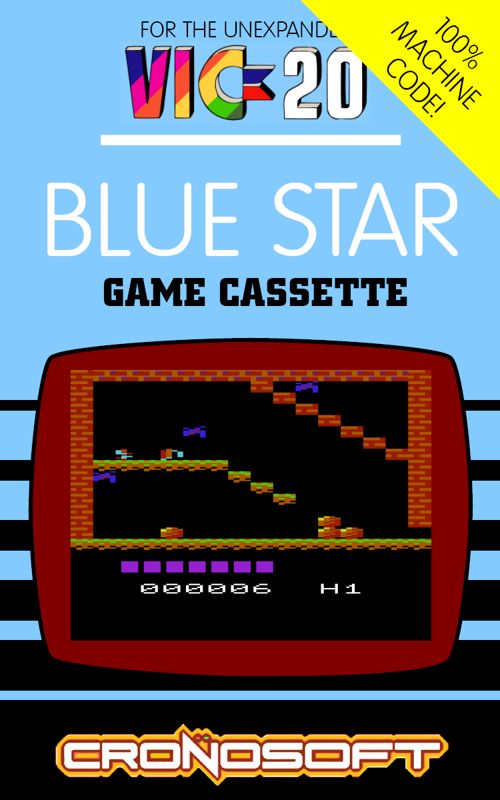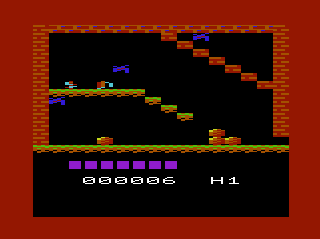Retro Replay Review
Gameplay
Blue Star delivers a tightly tuned, open‐ended platforming experience that feels remarkably ambitious given the unexpanded VIC-20 hardware. Players begin with only a basic suit and blaster, then gradually expand their capabilities by discovering hidden upgrades scattered throughout the alien base. The pacing is well balanced: early areas introduce fundamental movement and shooting mechanics, while later zones demand more precision and creative use of acquired gear.
The progression system hinges on exploration and backtracking, encouraging you to commit key items like the jet pack or rocket launcher strategically. This design choice fosters a genuine sense of discovery: stumbling upon a previously inaccessible chamber after finding double‐jump thrust is genuinely rewarding. Enemy placements and hazard traps are thoughtfully arranged to test both your reflexes and your mastery of the new tools.
Controls are responsive, with crisp jump inputs and reliable shooting that minimize frustration in the heat of battle. The level layouts are cleverly intertwined, offering shortcuts and secret passages that hint at designer finesse. While the challenge spikes sharply in some sections—particularly when facing clustered foes or platforming over bottomless pits—checkpoint placement strikes a reasonable balance between tension and fairness.
Graphics
On a platform as limited as the VIC-20, Blue Star’s visual presentation is surprisingly polished. The game employs a restrained color palette, leveraging bold primary hues to delineate foreground platforms, background elements, and enemy sprites. Despite the hardware’s constraints, each area boasts unique environmental themes—ranging from sterile control rooms to lava‐lined caverns—helping to maintain visual interest throughout the journey.
Character and enemy sprites are simple yet expressive: armored aliens swivel in place before charging, and the player’s jet pack thrusters flicker convincingly during airborne maneuvers. Animation frames are kept to a minimum, but they’re well designed to convey motion and personality. In moments of high action, sprites remain clear and legible, avoiding the flicker or slowdown that could otherwise hamper the experience.
Background details—such as pulsating energy conduits or flickering warning lights—add a layer of atmosphere without cluttering the screen. Transitions between rooms are accompanied by brief loading pauses, but these are short enough to feel natural. Overall, Blue Star demonstrates that smart art direction can overcome technical limits, delivering a cohesive and engaging retro aesthetic.
Story
Blue Star’s narrative is minimalist yet effective, setting you on a mission to infiltrate an alien installation and neutralize its central CPU core. While there are no lengthy cutscenes or voiceovers, the game conveys stakes through environmental storytelling—scrawled warnings on corridor walls, overheard automation messages, and the occasional emergency broadcast. This sparse approach lets players fill in the blanks with their own imaginations.
The sense of mystery deepens as you uncover logs and data terminals, each offering cryptic insights into the aliens’ experiments. Collecting these narrative fragments feels optional, but piecing them together adds valuable context: why the base exists, what powers the CPU, and what potential threat it poses to humanity. This subtle lore‐building rewards thorough explorers without burdening those who prefer to dive straight into the action.
Boss encounters at key nodes reinforce the story beats by visualizing the CPU’s defenses in increasingly elaborate forms. From missile‐turret crabs to energy‐shielded sentinels, these adversaries embody the base’s evolving security measures. Defeating each boss doesn’t just unlock new equipment—it also accelerates the narrative push toward the final confrontation, ensuring the objective remains clear and compelling throughout.
Overall Experience
Blue Star stands out as an inventive homage to classic Metroidvania titles, distilled into a small-scale package that runs on retro hardware. Its combination of exploration, item‐based progression, and atmospheric presentation delivers a surprisingly modern experience through an authentic 1980s lens. Enthusiasts of pixel‐perfect platforming and clever level design will find plenty to admire here.
While the difficulty may deter casual players unaccustomed to retro challenge curves, those who embrace its demands will appreciate the well‐paced learning curve and fair checkpoint system. The game’s soundtrack and sound effects further elevate the immersion, providing rhythmic chiptune beats that adapt to different environments and battle sequences.
In sum, Blue Star is a testament to what dedicated indie developers can achieve on vintage hardware. It offers hours of engaging exploration, thoughtful combat, and atmospheric world-building. For collectors, retro gaming fans, or anyone seeking a compact yet robust Metroidvania experience, Blue Star is a clear recommendation and a solid addition to the VIC-20 library.
 Retro Replay Retro Replay gaming reviews, news, emulation, geek stuff and more!
Retro Replay Retro Replay gaming reviews, news, emulation, geek stuff and more!





Reviews
There are no reviews yet.